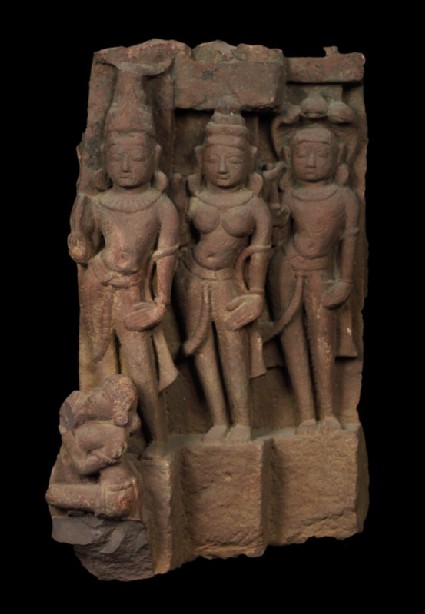Browse: 20 objects
- Reference URL
Actions
Fragment of a donor group possibly depicting Vasudeva, Subhadra, and Balarama
-
Details
- Associated place
-
Asia › India › north India (place of creation)Asia › India › central India › Madhya Pradesh › Malwa (possible place of creation)
- Date
- 11th - 12th century (1001 - 1200)
- Material and technique
- red sandstone
- Dimensions
- 50 x 33 x 22 cm approx. (height x width x depth)
- Material index
- Technique index
- Object type index
- No. of items
- 1
- Credit line
- Purchased, 1968.
- Accession no.
- EA1961.168
-
Further reading
Harle, J. C., and Andrew Topsfield, Indian Art in the Ashmolean Museum (Oxford: Ashmolean Museum, 1987), no. 54 on p. 46, p. 49, illus. p. 45
Location
-
- currently in research collection
Objects are sometimes moved to a different location. Our object location data is usually updated on a monthly basis. Contact the Jameel Study Centre if you are planning to visit the museum to see a particular object on display, or would like to arrange an appointment to see an object in our reserve collections.
Publications online
-

Indian Art in the Ashmolean Museum
This little group, including the small donor figure, stood at the base, on one side of the surround of a large image, most likely Viṣṇu. Such elaborately carved surrounds are a feature of large stele after the Gupta period and with their superimposed figures and motifs and elaborate symbolism they have much in common with the doorways of the period [see EAO.S. 71].
The figures are easily recognizable as Kṛṣṇa, holding the discus in his right hand, or more likely Vāsudeva, because of his crown, Subhadrā, holding what appears to be a lotus, and Balarāma, identifiable by the hala (plough) he is holding and his serpent hood. They are thus clearly representative, even at this comparatively late date, of members of the family group of five folk heroes at the origin of much of the cult of Viṣṇu [see EAOS.38.a]. Their relation to the iconographical grouping known as Ekānaṃśa (“the single portionless, or undivided one”), with the goddess as the central figure, cannot be discerned in this fragmentary context.
© 2013 University of Oxford - Ashmolean Museum

